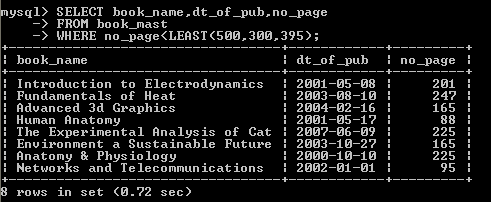MySQL LEAST() function
LEAST() function
MySQL LEAST() function returns the smallest argument from two or more arguments.
This function is useful in -
- LEAST() is useful in conditional logic, allowing you to determine the smallest value among a set of options, which is particularly useful in decision-making processes.
- It provides a convenient way to find the smallest value among a set of expressions or column values.
- LEAST() returns NULL if any of the input values are NULL.
- Using LEAST() makes queries more readable and understandable, as it clearly states the intention to find the minimum value.
- It can be used in mathematical calculations where you need to find the minimum value among a set of numeric expressions.
- This is especially useful when dealing with complex queries involving multiple conditions.
Syntax:
LEAST(value1,value2,...)
The arguments are compared using the following rules:
- If any argument is NULL, the result is NULL. No comparison is needed.
- If the return value is used in an INTEGER context or all arguments are integer-valued, they are compared as integers.
- If the return value is used in a REAL context or all arguments are real-valued, they are compared as reals.
- If the arguments comprise a mix of numbers and strings, they are compared as numbers.
- If any argument is a nonbinary (character) string, the arguments are compared as nonbinary strings.
- In all other cases, the arguments are compared as binary strings.
MySQL Version: 8.0
Example: MySQL LEAST() function
The following MySQL statement will find the smallest out of the list of arguments.
Code:
-- This query uses the LEAST() function to find the smallest value among the given arguments.
SELECT LEAST(15, 10, 25);
-- The LEAST() function compares the provided values and returns the smallest one.
Explanation:
- The purpose of this SQL query is to determine the smallest value among a set of provided values using the LEAST function.
- SELECT LEAST(15, 10, 25): This part of the query uses the LEAST function to compare the values 15, 10, and 25.
- The LEAST function evaluates the given arguments and returns the smallest value among them.
- In this case, it compares the three values: 15, 10, and 25.
- Among these values, 10 is the smallest.
Output:

Example: MySQL LEAST() function using string
The following MySQL statement will find the smallest out of the list of arguments. It returns M, since S and Z come after M.
Code:
-- This query uses the LEAST() function to find the smallest value among the given string arguments.
SELECT LEAST("Z", "M", "S");
-- The LEAST() function compares the provided string values lexicographically and returns the smallest one.
Explanation:
- The purpose of this SQL query is to determine the smallest string value among a set of provided string values using the LEAST function.
- SELECT LEAST("Z", "M", "S"): This part of the query uses the LEAST function to compare the string values "Z", "M", and "S".
- The LEAST function evaluates the given string arguments and returns the smallest value based on lexicographical (dictionary) order.
- In this case, it compares the three string values: "Z", "M", and "S".
- In lexicographical order, "M" comes before "S" and "Z".
Output:

Example: MySQL LEAST() function with where clause
The following MySQL statement will fetch those books from book_mast table which have less number of pages than lowest argument returning from the LEAST() function.
Sample table: book_mast
Code:
-- Selects the columns book_name, dt_of_pub, and no_page from the book_mast table
SELECT book_name, dt_of_pub, no_page
-- Specifies the table from which to retrieve the data
FROM book_mast
-- Filters the rows to include only those where the number of pages (no_page) is less than the smallest value among 500, 300, and 395
WHERE no_page < LEAST(500, 300, 395);
Explanation:
- SELECT book_name, dt_of_pub, no_page:
- This part of the query specifies the columns to be retrieved from the book_mast table.
- book_name: The name of the book.
- dt_of_pub: The date of publication of the book.
- no_page: The number of pages in the book.
- FROM book_mast:
- This specifies the table from which to retrieve the data. In this case, it is the book_mast table.
- WHERE no_page < LEAST(500, 300, 395):
- This clause filters the rows to include only those where the number of pages (no_page) is less than the smallest value among the numbers 500, 300, and 395.
- LEAST(500, 300, 395): This function compares the values 500, 300, and 395, and returns the smallest value, which is 300 in this case.
- So, the WHERE clause effectively becomes WHERE no_page < 300, filtering the rows to include only those books with fewer than 300 pages.
Output:

Slideshow of MySQL Comparison Function and Operators
Previous: ISNULL()
Next: LESS THAN OR EQUAL OPERATOR(<=)
